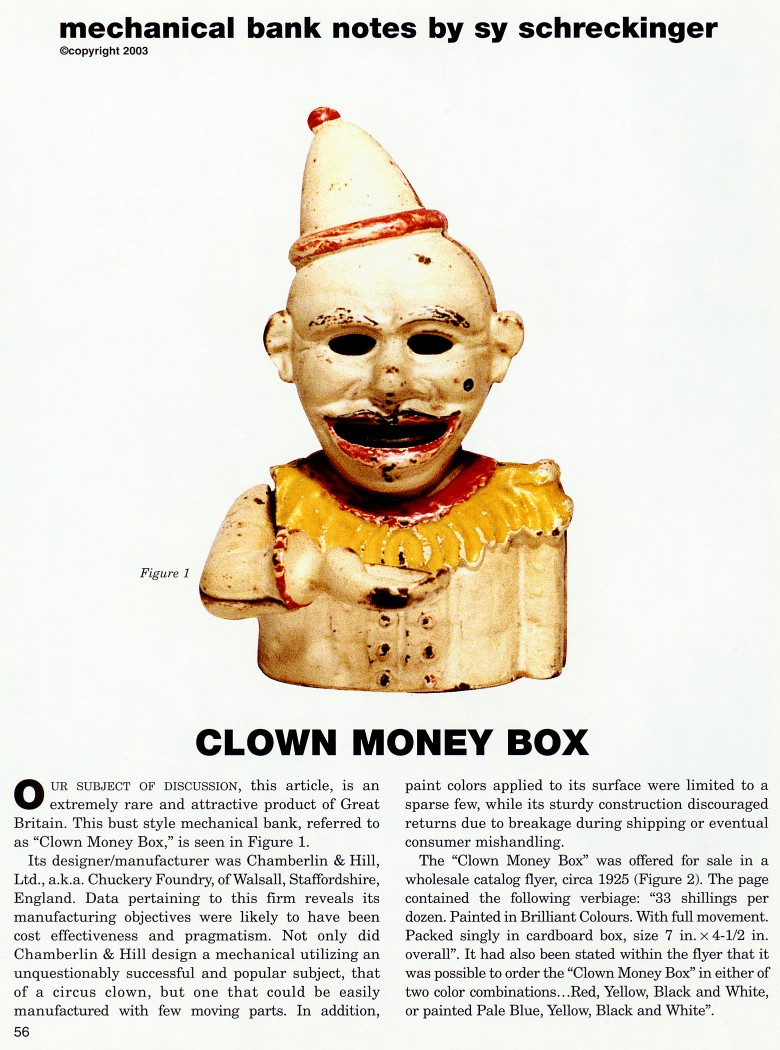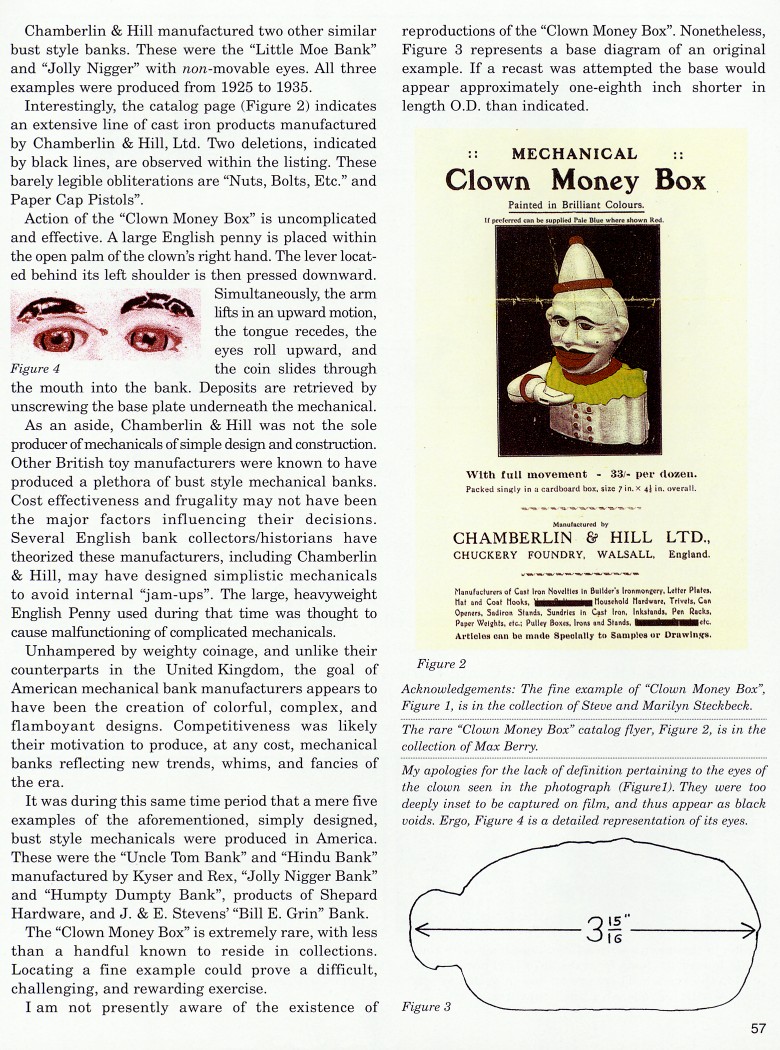|
Clown Money Box
by Sy Schreckinger – ANTIQUE TOY WORLD Magazine – July, 2003
Our subject of discussion, this article, is an
extremely rare and attractive product of Great Britain. This bust style
mechanical bank, referred to as "Clown Money Box," is seen in Figure 1.
Its designer/manufacturer was Chamberlin & Hill, Ltd., a.k.a.
Chuckery Foundry, of Walsall, Staffordshire, England. Data pertaining to
this firm reveals its manufacturing objectives were likely to have been
cost effectiveness and pragmatism. Not only did Chamberlin & Hill design a
mechanical utilizing an unquestionably successful and popular subject,
that of a circus clown, but one that could be easily manufactured with few
moving parts. In addition, paint colors applied to its surface were
limited to a sparse few, while its sturdy construction discouraged returns
due to breakage during shipping or eventual consumer mishandling.
The "Clown Money Box" was offered for sale in a wholesale catalog
flyer, circa 1925 (Figure 2). The page contained the following verbiage:
"33 shillings per dozen. Painted in Brilliant Colours. With full movement.
Packed singly in cardboard box, size 7 in. x 4-1/2 in. overall". It had
also been stated within the flyer that it was possible to order the "Clown
Money Box" in either of two color combinations...Red, Yellow, Black and
White, or painted Pale Blue, Yellow, Black and White".
Chamberlin & Hill manufactured two other similar bust style banks. These
were the "Little Moe Bank" and "Jolly Nigger" with non-movable eyes. All
three examples were produced from 1925 to 1935.
Interestingly, the catalog page (Figure 2) indicates an extensive
line of cast iron products manufactured by Chamberlin & Hill, Ltd. Two
deletions, indicated by black lines, are observed within the listing.
These barely legible obliterations are "Nuts, Bolts, Etc." and Paper Cap
Pistols".
Action of the "Clown Money Box" is uncomplicated and effective. A
large English penny is placed within the open palm of the clown's right
hand. The lever located behind its left shoulder is then pressed downward.
Simultaneously, the arm lifts in an upward motion, the tongue recedes, the
eyes roll upward, and the coin slides through the mouth into the bank.
Deposits are retrieved by unscrewing the base plate underneath the
mechanical.
As an aside, Chamberlin & Hill was not the sole producer of
mechanicals of simple design and construction. Other British toy
manufacturers were known to have produced a plethora of bust style
mechanical banks. Cost effectiveness and frugality may not have been the
major factors influencing their decisions. Several English bank
collectors/historians have theorized these manufacturers, including
Chamberlin & Hill, may have designed simplistic mechanicals to avoid
internal "jam-ups". The large, heavyweight English Penny used during that
time was thought to cause malfunctioning of complicated mechanicals.
Unhampered by weighty coinage, and unlike their counterparts in the
United Kingdom, the goal of American mechanical bank manufacturers appears
to have been the creation of colorful, complex, and flamboyant designs.
Competitiveness was likely their motivation to produce, at any cost,
mechanical banks reflecting new trends, whims, and fancies of the era.
It was during this same time period that a mere five examples of the
aforementioned, simply designed, bust style mechanicals were produced in
America. These were the "Uncle Tom Bank" and "Hindu Bank" manufactured by
Kyser and Rex, "Jolly Nigger Bank" and "Humpty Dumpty Bank", products of
Shepard Hardware, and J. & E. Stevens' "Bill E. Grin" Bank.
The "Clown Money Box" is extremely rare, with less than a handful
known to reside in collections. Locating a fine example could prove a
difficult, challenging, and rewarding exercise.
I am not presently aware of the existence of reproductions of the
"Clown Money Box". Nonetheless, Figure 3 represents a base diagram of an
original example. If a recast was attempted the base would appear
approximately one-eighth inch shorter in length O.D. than indicated.
Acknowledgements: The fine example of "Clown Money Box", Figure 1, is
in the collection of Steve and Marilyn Steckbeck.
The rare "Clown Money Box" catalog flyer, Figure 2, is in the
collection of Max Berry.
My apologies for the lack of definition pertaining to the eyes of the
clown seen in the photograph (Figure1). They were too deeply inset to be
captured on film, and thus appear as black voids. Ergo, Figure 4 is a
detailed representation of its eyes.
|

